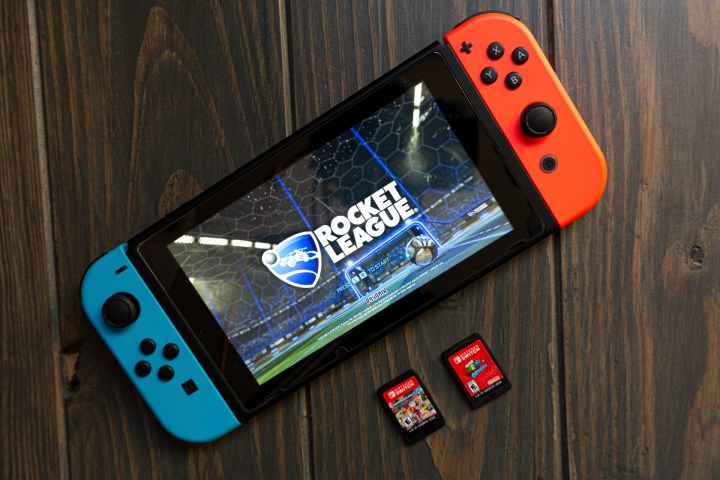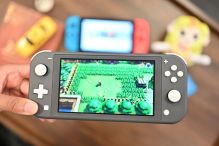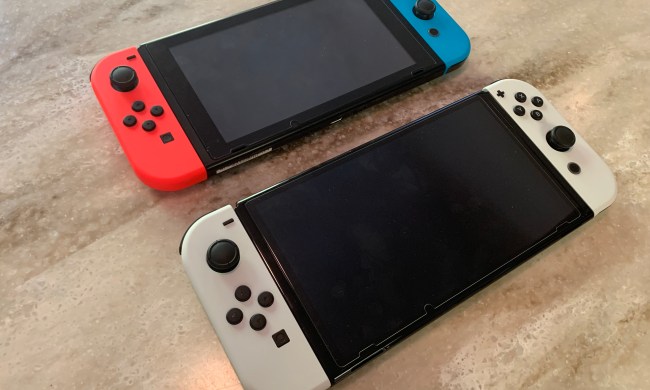If you haven’t picked up the Nintendo Switch yet, you now have two distinct options to choose from. There’s the original system, which offers portability and docked television play alongside removable Joy-Con controllers, and there’s the Nintendo Switch Lite, the smaller, cheaper alternative.
The Switch Lite is similar to the original handheld but features some significant design changes that might pique or quell your interest. Both are considerable choices, but determining which is the best for you depends on what you’re looking for. We’ve broken down how each console differs to make your decision easier — we’ve even rounded up the best Nintendo Switch deals available now.
See more
Specs
Nintendo Switch |
Nintendo Switch Lite |
|
| Dimensions | 10 x 4.2 x .55 inches | 8.2 x 3.6 x 0.55 inches |
| Weight | 0.66 pounds without controllers, 0.88 pounds with controllers | 0.61 pounds |
| Processor | Nvidia customized Tegra/Tegra X1+ | Nvidia customized Tegra X1+ |
| RAM | 4GB | 4GB |
| Storage | 32GB of flash storage, expandable through MicroSD | 32GB of flash storage, expandable through MicroSD |
| A/V output | HDMI out | No |
| I/O Output | 1 USB-C, USB 3.0, USB 2.o x2 | 1 USB-C |
| Communication | Wi-Fi, Bluetooth 4.1 | Wi-Fi, Bluetooth 4.1 |
| Controller | Joy-Con or Pro Controller | Built into system |
| Screen size and resolution | 6.2 inches, 720p | 5.5 inches, 720p |
| Battery life | Up to 6.5 hours for old model, 9 hours for new model | Up to 7 hours |
| Physical media | Proprietary cartridge | Proprietary cartridge |
| Availability | Available Now | Available Now |
| DT review | 4/5 stars | 4.5/5 stars |
Design and features

The standard Nintendo Switch is a hybrid console. It can be played as a handheld system or in “tabletop” mode with its included kickstand, and as a home console when placed in its dock. Its power isn’t its biggest selling point, falling somewhere between the Wii U and the standard Xbox One and PlayStation 4 consoles. What makes the Switch special is the many ways it can be used, though.
Outside of its dock, the Switch functions as a typical handheld system. A Joy-Con controller is locked onto either side with the same button layout and sticks you’d expect on a standard gamepad. At any time, however, you can remove the Joy-Con controllers and place the system in its dock and begin playing the system as a home console. This “switch” happens instantly, and you can remove the console from the dock to play as a handheld system just as swiftly.
The Switch Lite doesn’t have many of the features that make the Switch unique, and this is reflected in its reduced price. The system doesn’t come with a dock, nor is there any way to connect it to a television.
The controls on either side resemble the Joy-Con controllers, but they are a permanent part of the system. Its weight and screen size have both been reduced, with the latter shrinking from 6.2 inches to 5.5 inches. Both systems have a 720p-capable screen.
However, the biggest difference comes from the new custom Tegra X1+ chip. Although its capabilities are nearly identical to the original Switch, it’s much more efficient, leading to longer battery life in the Switch Lite, up to 7.5 hours. Nintendo quietly released a revision of the original Switch with this new processor, nearly double the battery life of the original console. Unfortunately, the only way to tell if it’s a new Switch is by the box and serial number. If it’s a red box, it’s the new Switch. Likewise, if the serial number starts with “XKW,” it’s the new one. Outside of the new processor, the two models are the same.
Cloud saves are supported on the Switch so long as you have a Nintendo Switch Online subscription, so you’ll likely be able to access your game progress across both systems in that way. There is a selection of games like Pokémon: Let’s Go, however, that don’t have cloud saving enabled.
As for the ability to transfer data between the two devices, it’s possible, though not instantaneously. Just as you would do going from one Switch to another, you can transfer your entire account to the Switch Lite if you want to pick one up. However, you can’t go back and forth unless you transfer your profile manually each time.
Controller

The original Nintendo Switch comes with two Joy-Con controllers in the basic package, as well as the Joy-Con grip. When attached to the Switch, the Joy-Con controllers function identically to how the controls work on the Switch Lite. When detached, however, you have far more options.
Turned sideways, one Joy-Con controller can be used on its own, much like a classic NES gamepad, and buttons inside the rail portion can be raised with the included Joy-Con straps. This lets you essentially play a two-player game wherever you are, such as Mario Kart 8 Deluxe or New Super Mario Bros. U Deluxe.
If you place both Joy-Con controllers in the Joy-Con grip, they resemble the look and feel of a traditional gamepad, and this is the primary way to play games while docked unless you purchase a Pro Controller.
Though the Switch Lite does support these controllers via Bluetooth connection, its own controls are not detachable. As such, you will need to purchase at least one Joy-Con controller to play the system with a friend, as well as a stand to place it down since the kickstand found on the standard Switch has been removed from the Switch Lite.
Still, the fixed controls do mean the Switch Lite gets a full-fledged directional pad. For certain platforming games that demand precise jumps, this could make the Switch Lite the preferred option, at least among those who do not want to play their games on a TV.
One type of controller that will apparently not be supported by the Switch Lite at all is the GameCube controller. An adapter is available to use this controller on the standard Switch, but it connects via a USB port on the dock rather than directly to the console. No dock with the Switch Lite, no USB port.
Games

The Nintendo Switch and the Nintendo Switch Lite play almost the same library of games, and with the proper accessories, you can achieve complete parity between the two systems. Out of the box, however, there are a few titles you cannot enjoy on the Switch Lite.
Super Mario Party can only be played in either tabletop or docked mode because it makes heavy use of the Joy-Con controllers’ unique motion features. The same is true for launch title 1-2 Switch, which utilizes “HD Rumble” for some of its mini-games.
Without buying a few Joy-Con controllers (and a Grip to keep them charged), these games will not work on Switch Lite. They can run without extra Joy-Cons, but they’re not exactly playable. Certain modes also will be inaccessible in other games. You won’t be able to use motion controllers to flick your Poké Ball in Pokémon: Let’s Go, for instance.
Accessories

The other major incompatibility with Switch Lite is Nintendo Labo. The graphics are programmed to fit the original Switch, so the sets don’t look right on the Switch Lite. Labo also uses Joy-Con controllers, which aren’t compatible with the Switch Lite. That means the VR modes added to The Legend of Zelda: Breath of the Wild and Super Mario Odyssey won’t be available to Switch Lite owners.
There are plenty of incredible cases, skins, and screen protectors designed specifically for the Nintendo Switch Lite. Because it’s tinier than the Switch, the conventional accessories won’t fit well on the latest device. Still, they can’t match the classic Nintendo Switch’s massive number of accessories, several of which are not supported by the Switch Lite. Cases, screen shields, and guard shells, for instance, will all be too massive. There are a few items that will work well, though, like headsets (using a 3.5mm input) and control stick covers.
Price and release date

The regular Nintendo Switch system is available now. The sale value is $300, but it’s usually much cheaper when there’s a sale going on, such as Prime Day and Black Friday. The regular system comes in dark gray or neon red and blue colors, with picturesque special edition consoles making their way on the scene too.
The Switch Lite is $200 is available in a variety of fun and different colors like coral, yellow, gray, and turquoise. A special edition for Pokémon Sword and Shield was released quickly following the launch but sold out immediately.




